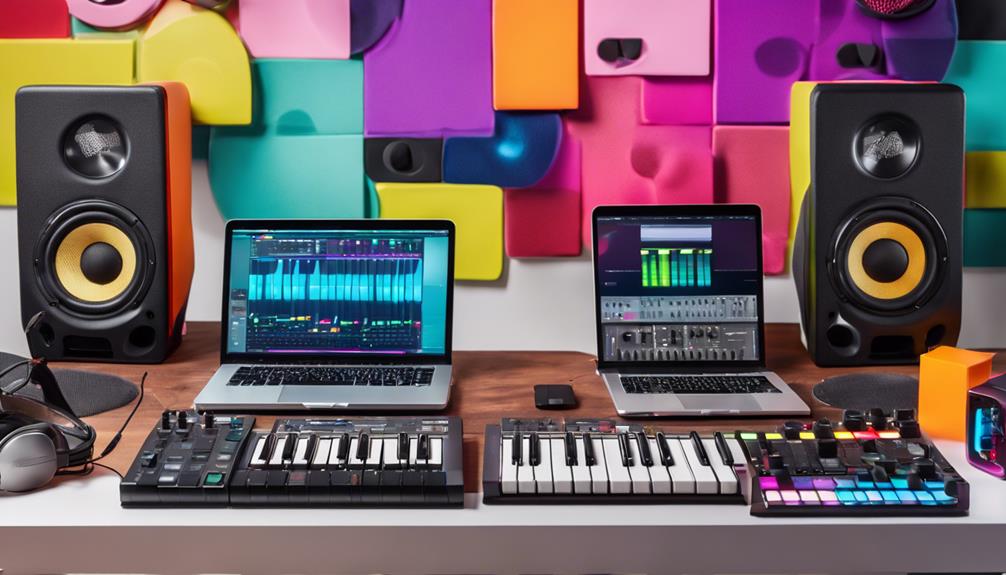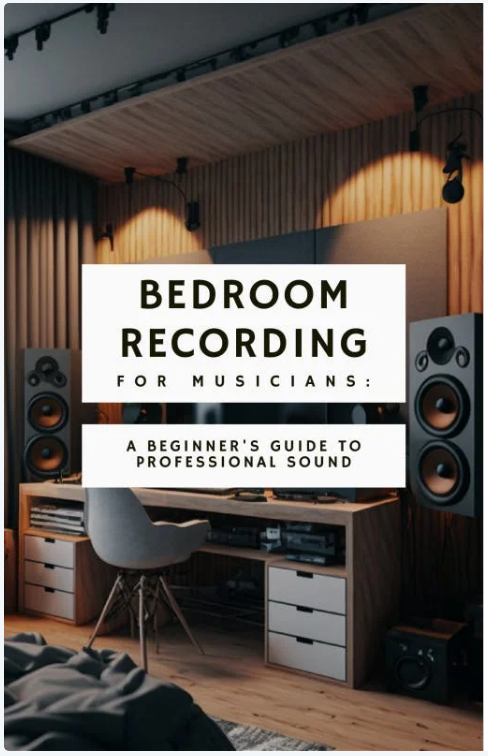Table of Contents
As a beginner in music production, having key gear is essential for your creative excursion. Essential equipment, like a reliable computer with a sturdy Digital Audio Workstation (DAW), guarantees smooth recording and editing. An audio interface helps you achieve professional sound quality by connecting instruments and microphones. Quality studio monitors and headphones are crucial for accurate mixing, allowing your tracks to translate well across systems. Don’t overlook the value of a MIDI controller for intuitive music input. This foundation not only enhances your workflow but also opens the door to exploring various music-making techniques and tools. There’s much more to uncover.
Importance of Essential Equipment
In music production, having the right equipment isn’t just advantageous; it’s fundamental. If you’re serious about creating music, you need to invest in fundamental equipment that enhances your workflow and sound quality. A reliable computer with at least 16GB of RAM is essential for managing extensive audio files and running your Digital Audio Workstation (DAW) smoothly.
The DAW itself is your primary tool for recording, editing, and mixing, so choosing one that suits your style is vital. Additionally, acoustic treatment basics help minimize unwanted reflections and echoes, guaranteeing a cleaner recording environment.
An audio interface plays a significant role as well, converting analog signals from your microphones and instruments into digital format, which guarantees professional recording quality.
To achieve accurate sound representation, you should also consider studio monitors and headphones. They allow you to hear your mixes clearly, which is critical for effective mixing and production.
Lastly, a MIDI controller can greatly enhance your creative input. It provides intuitive control over virtual instruments and software within the DAW, streamlining your music production process.
Key Gear for Beginners
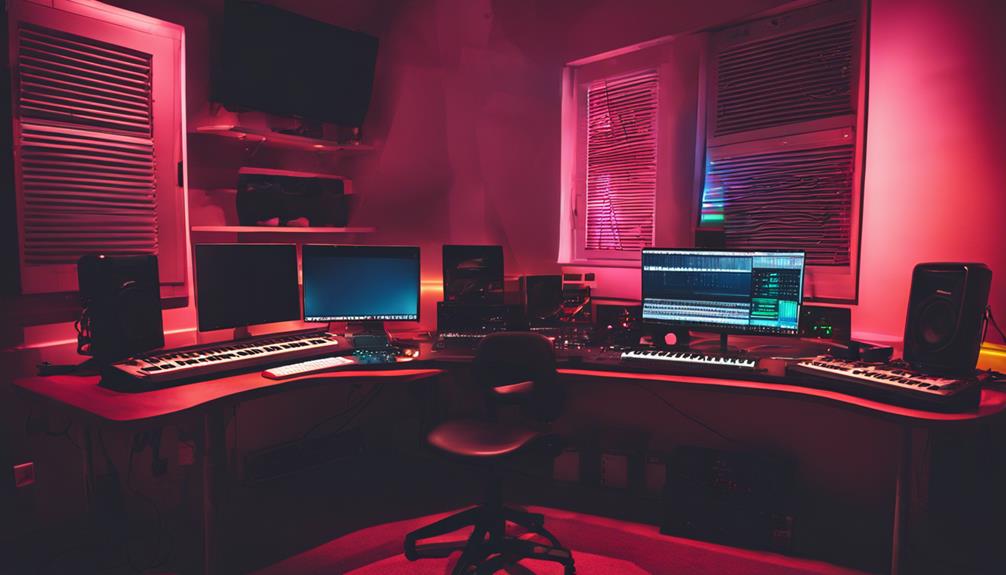
Choosing the right gear as a beginner in music production is vital for establishing a solid foundation. Start with a Digital Audio Workstation (DAW), your primary software for recording and editing audio. Popular choices like GarageBand offer user-friendly interfaces, while Ableton Live provides creative flexibility.
It’s also important to take into account essential recording gear to maximize your setup’s potential. Next, invest in a MIDI controller; this tool allows you to intuitively input melodies and beats, with compact 25-key models being particularly space-efficient.
An audio interface is important as well, as it connects your microphones and instruments to your computer, ensuring you capture high sound quality. Entry-level options like the Focusrite Scarlett 2i4 are perfect for beginners.
For recording vocals, a reliable studio microphone, such as the Shure SM58, can make a significant difference in clarity and quality.
Additionally, don’t overlook monitoring equipment. Quality studio headphones, like the Sony MDR series, help you accurately assess your mixes, while studio monitors like JBL LSR 305s provide a flat response for a true representation of your sound.
Choosing the Right DAW
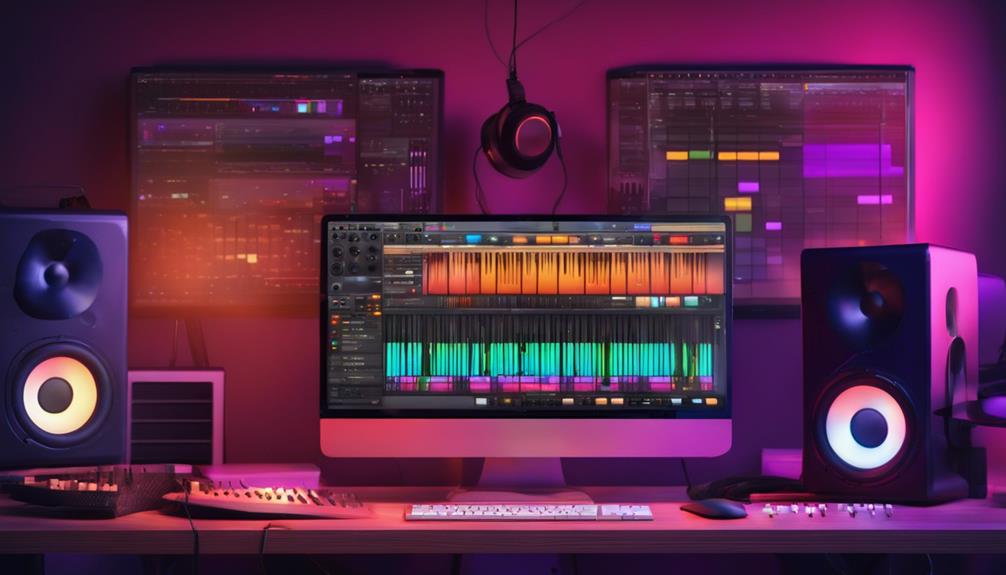
Selecting the right Digital Audio Workstation (DAW) can greatly impact your music production experience. As a beginner, understanding the various options available will help you make an informed choice that aligns with your goals. Here are three key factors to take into account when choosing a DAW:
1. Compatibility: Verify the DAW works seamlessly with your computer’s operating system and hardware specifications. Check the minimum requirements to avoid performance issues that can stifle your creativity.
Additionally, investing in a powerful computer is vital for music production, as it supports the DAW’s functionalities and enhances overall performance, especially when working with larger projects essential equipment for home studios.
2. Workflow: Different popular DAWs like Logic Pro, Ableton Live, and FL Studio cater to unique production styles. Reflect on how intuitive the interface is for you—an efficient workflow can greatly improve your recording, editing, and mixing audio tracks.
3. Trial Versions: Many DAWs offer free or trial versions, such as Reaper’s 60-day free trial. Trying these out allows you to investigate functionality without financial commitment, making it easier to find what suits you best.
Sound Monitoring Essentials
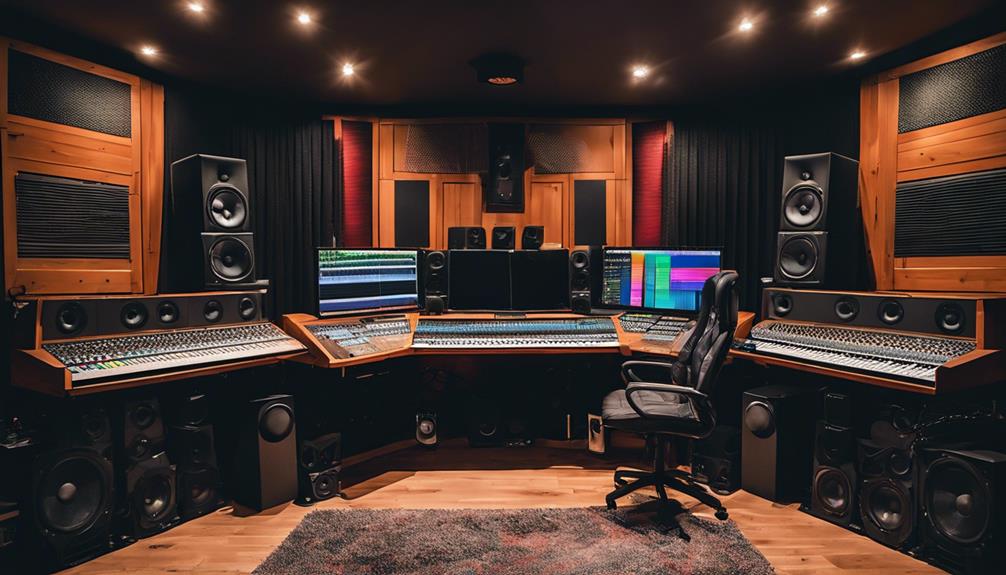
Achieving a polished sound requires investing in quality sound monitoring essentials. First, studio monitors are essential, as they provide accurate audio playback with a flat frequency response, enabling you to make informed mixing decisions. This precision guarantees that your tracks translate well across different playback systems.
For detailed listening, high-quality studio headphones are critical. Designed to deliver a neutral sound without coloration, they’re especially beneficial when your mixing environment isn’t acoustically optimized. They allow you to catch subtleties in your mix that you might miss otherwise.
Don’t overlook acoustic treatment in your space. By reducing echoes and vibrations, it greatly improves the performance of your studio monitors, leading to clearer audio monitoring.
Additionally, investing in cables of good quality, such as Mogami XLR cables, is necessary for the best audio performance. Poor cables can introduce noise and degrade your sound.
Lastly, regularly checking your mixes on various playback systems—like car speakers and earbuds—guarantees your music sounds good everywhere. This practice is essential for emerging producers who want their tracks to connect with listeners across different listening environments.
Prioritize these sound monitoring essentials, and you’ll be well on your way to professional-quality music production.
MIDI and Music Creation Tools
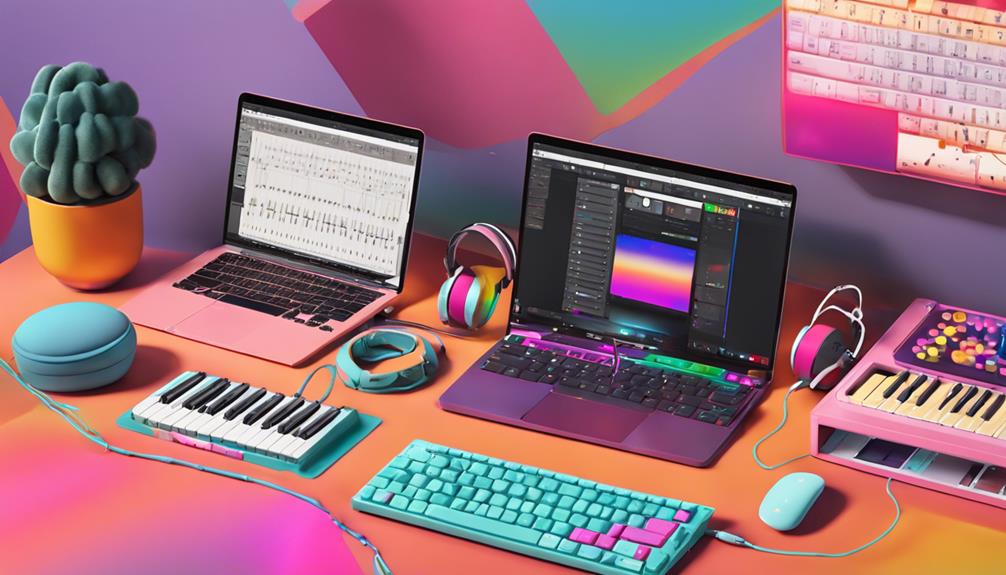
MIDI keyboards are essential for music production, allowing you to input melodies with greater expressiveness than a mouse.
By choosing the right size for your space, you can maximize your creative potential while enhancing your workflow.
Coupling these tools with effective use of sound libraries expands your sonic palette, providing endless opportunities to uplift your tracks.
Importance of MIDI Keyboards
Often overlooked by beginners, MIDI keyboards play an essential role in modern music production by streamlining the process of creating melodies and rhythms.
These MIDI controllers easily connect to your Digital Audio Workstation (DAW) via USB, eliminating the hassle of complicated setups. They enhance your creative workflow considerably, allowing you to focus on producing music rather than wrestling with technology.
Here are three key advantages of using MIDI keyboards:
- Versatile Tools: Many MIDI keyboards include drum pads, enabling intuitive beat-making and sample triggering. This feature is crucial for both beginners and advanced producers.
- Parameter Controls: Certain models come with built-in controls for adjusting various DAW parameters, such as volume and effects. This hands-on approach allows for greater control and creativity in your productions.
- Size Variety: With options ranging from 25-key models for limited spaces to 49-key versions for more extensive play, there’s a MIDI keyboard to fit your needs and style.
Incorporating a MIDI keyboard into your setup can drastically improve your music production experience, making it an essential tool for any budding musician.
Utilizing Sound Libraries Effectively
Sound libraries are priceless resources for music producers, offering a wealth of audio samples that can change your tracks into unique sonic experiences. By utilizing MIDI controllers, you can intuitively input and manipulate these sounds, making it easier to create melodies and beats in real-time. Many libraries, like those from Native Instruments, provide free samples, letting you experiment without financial commitment.
Incorporating sound libraries into your digital audio workstation (DAW) can considerably streamline your workflow. Here’s a quick overview of how sound libraries can improve your music production:
| Feature | Benefit | Examples |
|---|---|---|
| High-Quality Sounds | Enhance track quality | Native Instruments, Spitfire |
| Instant Access | Faster composition and arrangement | Plugins, DAW integration |
| Diverse Audio Samples | Unique textures and elements | Loops, one-shots |
Using plugins like Native Instruments Kontakt helps you access and manage these libraries efficiently, revealing a vast array of instruments for your creativity. Welcome sound libraries, and watch your composition skills soar as you craft innovative tracks!
Setting Up Your Home Studio
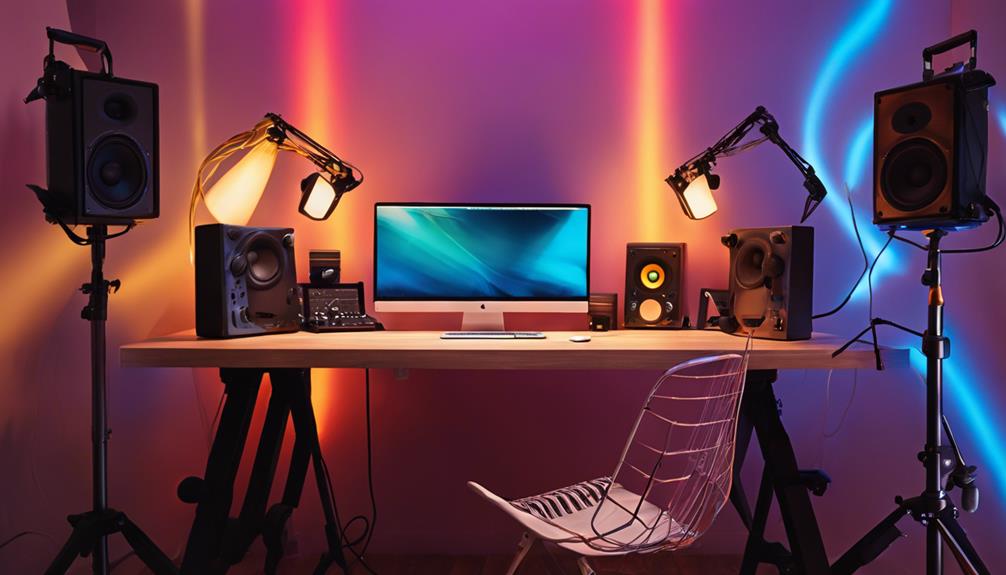
To create an effective home studio, you need to carefully select your workspace and guarantee it meets your production needs.
Start by making an essential equipment checklist, focusing on gear that maximizes your creativity without breaking the bank.
Don’t forget about acoustic treatment, as it can drastically improve the sound quality and clarity of your recordings.
Selecting Ideal Space
Creating the perfect environment for music production hinges on selecting an ideal space that minimizes external noise and maximizes functionality. The right setup can considerably enhance sound quality and streamline your workflow.
Here are three essential considerations when choosing your space:
- Noise Reduction: Opt for a quiet area away from traffic or household distractions. Sound interference can drastically affect your recordings, so prioritize isolation.
- Desk Setup: Organize your desk to keep your equipment easily accessible. A well-structured workspace reduces distractions, allowing you to focus entirely on your creative process.
- Acoustic Treatment: Implement acoustic solutions like foam panels and bass traps. These treatments control reflections and manage low frequencies, leading to clearer sound quality during recordings.
Additionally, make certain your power supply is reliable to avoid interruptions, and maintain proper cable management to reduce clutter and safeguard your equipment.
Essential Equipment Checklist
What vital gear do you need to initiate your home studio? First, a powerful computer with at least 16GB of RAM is fundamental. It’ll handle extensive audio files and run your digital audio workstation (DAW) smoothly. Choose a DAW that fits your style, like Logic Pro, Ableton Live, or FL Studio, as this will be the backbone of your music production.
Next, an audio interface is essential to connect your Condenser Microphone and instruments. It guarantees high-quality sound capture and playback, thanks to reliable preamps.
To accurately mix and refine your tracks, invest in studio monitors or high-quality studio headphones; both are vital for precise sound representation. Additionally, a MIDI controller will enhance your workflow, allowing you to input melodies and beats seamlessly.
Don’t forget vital accessories such as quality cables, like XLR for your microphone, and microphone stands. Collectively, this gear is vital for creating professional music. With the right equipment checklist, you’ll be well-equipped to commence your music production expedition and change your creative ideas into reality.
Acoustic Treatment Basics
Acoustic treatment plays an essential role in changing your home studio into a space that promotes clear sound recording and accurate mixing. To achieve the finest results, focus on these key components:
- Acoustic Panels: Strategically place these around your recording area to absorb excessive echoes. They help maintain recording clarity by reducing unwanted reverberations.
- Bass Traps: Install these in the corners of your studio to manage low frequencies, enhancing overall sound quality and ensuring your mixes translate well across systems.
- DIY Options: If you’re on a budget, consider foam panels or thick curtains as effective, cost-efficient solutions for improving your studio acoustics.
Experimenting with angles and distances is vital for finding the best sound capture and monitoring conditions.
Don’t hesitate to adjust your setup until you achieve the perfect balance. Effective acoustic treatment alters your home studio into a professional-sounding environment, enabling you to focus on creativity without the distraction of muddled sound.
Conclusion
In the world of music production, having the right gear can make all the difference in your creative expedition. Imagine crafting beats that echo, melodies that linger, and soundscapes that transport listeners. But without the essential tools, those dreams can fade into mere whispers. As you plunge deeper into your music-making exploration, remember: the right equipment isn’t just a luxury; it’s your gateway to releasing limitless potential. Are you ready to raise your sound and charm the world?

